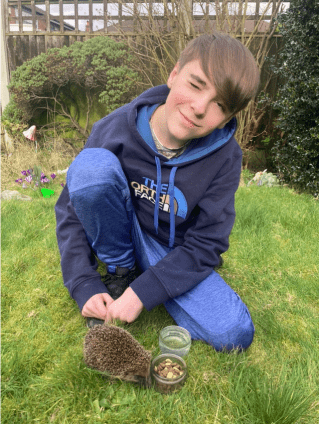When Lachlan Lasikiewicz turned gray one day, his lips a frightening blue, his grandma and aunt didn’t panic. They simply wrapped him up in a blanket and held him close, cuddling him and giving him comfort. While this moment seems incredibly scary for some, the Lasikiewicz family is managing the best they can. Lachlan has spontaneous periodic hypothermia, an ultra-rare condition presenting with recurrent hypothermic episodes in which the body temperature falls below 35°C (95°F).

Given the lack of general knowledge and understanding about spontaneous periodic hypothermia, Lachlan’s parents Donna and Mark do their best to make sure that Lachlan is safe, comfortable, and taken care of. They also work tirelessly to raise awareness about this condition. As Donna shares:
“I always felt so alone in the hospital while we were searching for a diagnosis. Hopefully, sharing Lachlan’s story may make someone else realize that they are not alone.”
Recently, Donna and I sat down to discuss the diagnostic journey, what we know about spontaneous periodic hypothermia, and how Lachlan is doing today.
Pursuing a Diagnosis
Parenting is complex; many first-time parents often feel anxious about their child’s health and safety. For Mark and Donna Lasikiewicz, some of their anxiety came from the fact that something seemed to be wrong with their newborn son Lachlan. He slept a lot—seemingly too much—and would sometimes turn pale or blue.
The first time Donna noticed this sensation was when she was getting Lachlan dressed. He was quiet and had a blue tinge to his lips. When Donna took his temperature, she was shocked that it read 32° Celsius (89.6° Fahrenheit). She explains:
“I couldn’t figure out what to do, so I turned to Google. But even with that, very little information came up. I called my mum-in-law, who lived around the corner, as I assumed I hadn’t taken his temperature correctly. She came by to take it but got the same result as me.”
On another occasion, Lachlan woke up from a nap on a snowy day. His temperature read 32°C. Donna called NHS Direct to ask for help, saying:
“The woman on the phone said that if I told her Lachlan had fallen into a pond, she would say he has hypothermia. I dug my car out of the snow and drove to the GP, trying to make sure I warmed Lachlan up along the way. By the time we reached the doctor, Lachlan’s temperature was 36°C (96.8°F).”
“I tried to explain to the doctor what had happened, but he said it was impossible for Lachlan to be alive and walking around with a temperature of 32°C. I cried and begged for him to listen, but he told me it just didn’t happen. No parent should be belittled to tears by a health professional. Just because someone hasn’t heard of a symptom or disease doesn’t mean it isn’t real.”
That day, when Donna left the doctor, she vowed that she would only take Lachlan to the hospital moving forward. She held true to that promise. When Lachlan’s symptoms worsened, Donna would take him to A&E. The doctors there were unsure what was going on. But this time, they listened to Donna’s concerns. Nobody dismissed her; in fact, consultants, nurses, and doctors often asked Lachlan questions, digging deeper to find a cause.
Two Years of Searching
Over the next few years, Lachlan underwent EEGs, ECGs, blood tests, MRIs, and more. The process was long and sometimes difficult, but the family had regular consultant appointments and Donna describes the hospital staff as lovely. Whenever his temperature dropped, the family had open access to call a special hospital ward and take him in. Donna shares:
“Every question we answered helped one more person become aware and I’m glad this might be used to help another family.”
Around Lachlan’s third birthday, the family received a surprise: a diagnosis. Although the consultant wasn’t entirely sure on what was happening, he had referred the Lasikiewicz family to a colleague of his. This colleague diagnosed Lachlan with spontaneous periodic hypothermia. He wrote the name on a scrap of paper for Donna. She remembers:
“He told me that I could Google it if I wanted, but there were only a few medical journals with any information. We tried to do more research, but the information just doesn’t exist. We had already been documenting Lachlan’s temperature drops and potential patterns, so we decided to put some information on a Facebook page.”
“I didn’t know if this would eventually help us learn more about spontaneous periodic hypothermia but felt that if someone else was on a similar journey, at least we could help with getting a faster diagnosis or learn more about what worked for them.”
Putting Lachlan’s journey into the world has actually helped the family to connect with others. At one point in time, the consultant asked Mark about Lachlan’s signs and symptoms. The family guessed that there might be another family whose child had been diagnosed; although they searched for this family, they had no luck. However, after Lachlan won the Local Child of Courage Award, which was covered in the local paper, the journalist received a call from another family—just two miles down the road from the Lasikiewicz family—whose child also has spontaneous periodic hypothermia. Meeting new friends and making those connections was one of the best parts of sharing their story.

Join us in Part 2 as we dive deeper into what spontaneous periodic hypothermia is and learn how Lachlan is doing today.







